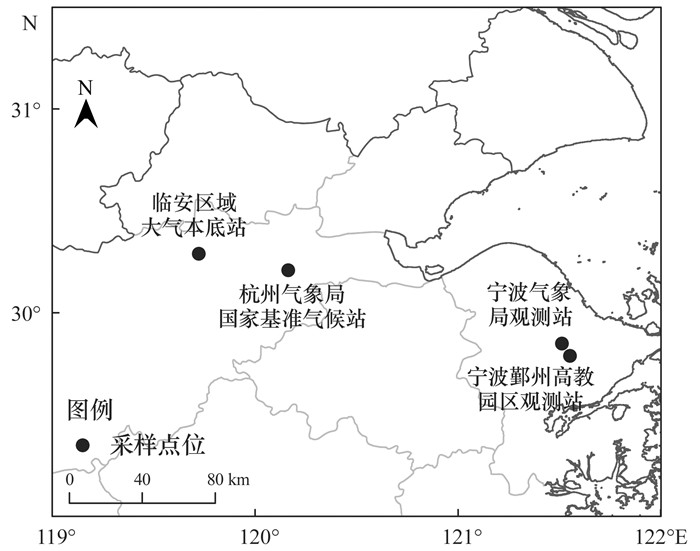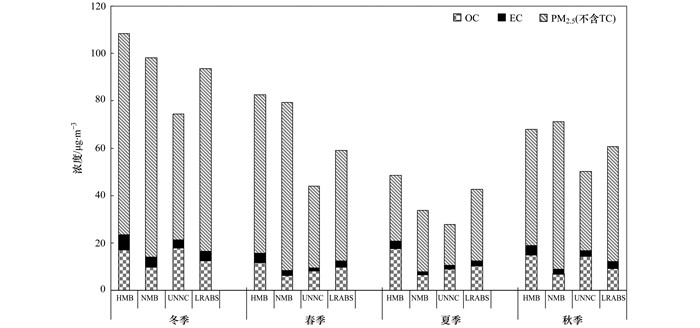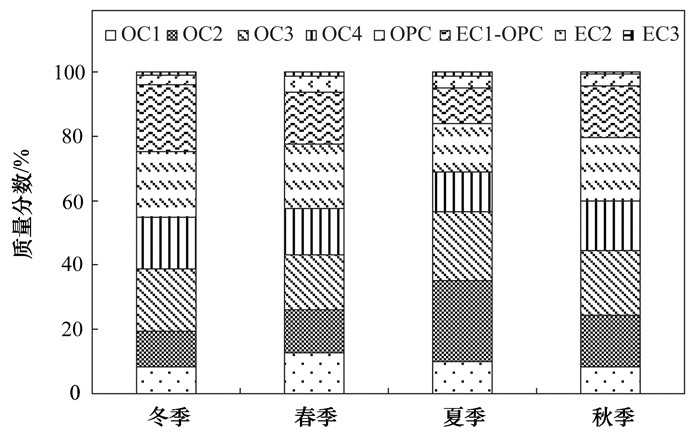2. 宁波诺丁汉大学化学环境工程系, 宁波 315100;
3. 杭州市气象局, 杭州 310051
2. Department of Chemical and Environmental Engineering, University of Nottingham Ningbo China, Ningbo 315100, China;
3. Hangzhou Meteorological Bureau, Hangzhou 310051, China
含碳气溶胶是大气细颗粒(PM2.5)的重要成分, 在城区PM2.5中所占比例可达到40%[1].含碳气溶胶通常分为有机碳(OC)和元素碳(EC), 后者在用光学方法测量时也被称为黑碳[2]. EC是继CO2之后导致全球变暖的第二大成分[3], 它对大气中太阳辐射强烈的吸收作用会减少到达地面的太阳辐射总量因而会导致作物减产[4, 5]. OC是由上百种有机物混合的复杂物质, 其中包括致癌多环芳香烃(PAHs), 脂肪链烃和有机酸等[6~8], 它能够吸收太阳辐射, 对气候和人类健康都会产生负面影响[9].
由于含碳气溶胶的重要性, 国内外已经开展了广泛的研究.目前, 我国含碳气溶胶的研究主要集中在京津冀、珠三角等地区[10, 11].长三角地区对霾及颗粒物的观测研究通常关注单个城市的污染事件(如上海、南京), 观测的物种或参数也大都单一[12~14].在浙江地区对含碳气溶胶的研究相对比较缺乏.
本研究针对浙江省主要的两大城市杭甬地区的大气细粒子开展了多点同步观测, 分析含碳气溶胶组分的浓度变化, 解析PM2.5中含碳物质的主要来源, 以期为厘清该区域内颗粒物中关键物种的来源和制定有效防治措施提供科学依据.
1 材料与方法 1.1 观测地点如图 1, 所选取的站点包含城区、城郊及偏远本底站, 观测点介绍如下.

|
图 1 采样点位置示意 Fig. 1 Locations of the sampling sites |
杭州气象局国家基准气候站(HMB; 经纬度:北纬30.22°, 东经120.17°):城区观测点, 位于杭州市区中心人口密集区域, 周围200 m区域内有交通密集的道路.
宁波气象局观测站(NMB; 经纬度:北纬29.86°, 东经121.52°):城区观测点, 位于宁波城市中心主干道(气象路)上, 和居民住宅区毗邻, 距离机场高架桥约1 km, 省际高速约500 m.
宁波鄞州高教园区观测站(UNNC; 经纬度:北纬29.80°, 东经121.56°):城郊观测点, 位于宁波市南部的大学园区宁波诺丁汉大学内, 距离中心商业区约10 km, 该区域作为同时被城区和郊区排放污染源影响的中间过渡区域.
临安区域大气本底站(LRABS; 经纬度:北纬30.30°, 东经119.73°):偏远地区观测点, 处于杭州市所辖临安市郊区, 是隶属于世界气象组织全球大气观测网络的本底监测站.监测站周围是农田和森林, 受到工业化和交通类排放的影响较小.
1.2 观测方法每个站点从2014年12月至2015年11月每6 d一次同步进行PM2.5采样.所用仪器为美国Airmetrics便携式采样器, 使用47 mm石英膜采样, 采样流速分别为5 L·min-1; 每月在这4个采样点取1次空白样本.所有的滤膜使用前在550℃的马弗炉内预烘烤5 h以去除残留的有机杂质.滤膜在采样前后皆在恒温(22±1)℃、恒湿(30±5)%下平衡24 h并通过微量天平(型号:SE2-F, 赛多利斯, 精确度0.1 μg)进行称重.然后将所有的滤膜包裹在预烘烤过的铝箔中并存储在-20℃以下直至进行样品分析.本研究中使用的气象数据(风速、降水、温度以及相对湿度)从距离每个采样点最近气象站获取, 相关数据见表 1.
|
|
表 1 采样期间杭甬地区4个采样点PM2.5的质量浓度和气象参数平均值 Table 1 PM2.5 concentrations and meteorological parameters during the sampling period |
1.3 实验方法
采用美国沙漠研究所(DRI)的碳热光学分析仪(型号2001A), 应用热光学反射(TOR)法来分析PM2.5中OC和EC含量.在分析过程中, 通过逐步加热滤膜(膜面积: 0.502 cm2)从室温到840℃来确定不同的碳成分, 其中包含在纯氦气中检测OC1 (140℃), OC2 (280℃), OC3 (480℃)和OC4+OPC (580℃), 在98% He/2% O2环境中检测EC1-OPC (580℃)、EC2 (740℃)和EC3 (840℃); 其中OPC特指热解有机碳[15]. OC的组成可视为OC1+OC2+OC3+OC4+OPC, EC的成分可视为EC1+EC2+EC3-OPC, 总碳(TC)指OC和EC含量之和.
2 结果与讨论 2.1 TC、OC和EC的浓度水平杭甬地区PM2.5中总碳的年均浓度为(14.3±4.1)μg·m-3, 占年均PM2.5浓度的(26.2±6.5)%.该结果与我国南部PM2.5中的总碳含量相当[TC: (15.0±2.6) μg·m-3][16], 低于北京(TC: 32.7 μg·m-3)[17], 然而比发达国家的许多城市例如西班牙巴塞罗那(TC: 5.1~9.5 μg·m-3), 荷兰阿姆斯特丹(TC: 5.6~8.6 μg·m-3)[18], 英国伯明翰(TC: 4.3 μg·m-3)都要高[19]. 4个采样点中, 总碳含量的年均值占PM2.5的比例从大到小依次为:UNNC (31.9%)>HMB (30.1%)>LRABS (25.8%)>NMB (17.2%).
杭甬地区PM2.5中OC的年均浓度为(11.3±3.4)μg·m-3, 其中最大值出现在HMB [(15.3±6.1) μg·m-3], 最小值在NMB [(7.2±3.5) μg·m-3].杭甬地区PM2.5中EC的年均浓度为(3.0±0.9) μg·m-3, 低于OC浓度. EC的最高浓度出现在HMB [(4.3±2.2) μg·m-3], 最低值出现在UNNC [(2.3±1.9) μg·m-3].最低的EC浓度水平出现在郊区UNNC, 这可能与该地区排放源较少并且风速是4个采样点最高[年均风速(2.3±0.8) m·s-1]有关, 强风有助于污染物的扩散.本研究中OC和EC的年均浓度和上海的观测结果相当(14.3 μg·m-3; 6.2 μg·m-3)[20], 但低于在北京的OC和EC的年均浓度(29.1 μg·m-3; 10.1 μg·m-3)[21].
如图 2所示, 冬季TC的浓度最高, 这与其它地区如北京[17]、广州[22]、上海[7]的结果一致.根据后向轨迹分析, 来自华北等高污染地区的远距离输送气团以及冬季静稳气象条件有利于污染物的积累, 可能是杭甬地区TC的浓度高的原因.夏季的TC浓度水平在4个采样点不相同, 但是所有采样点夏季TC/PM2.5的比值在四季中是最高的.太阳辐射和二次有机气溶胶的形成有很大相关性[23], 夏季强太阳辐射会导致产生相对更多的二次有机气溶胶, 这是TC/PM2.5比值高的原因之一.此外, 该地区夏季的火点(图 3)是四季中最多的, 夏季生物质的燃烧排放是一种重要来源, 贡献了较多的有机气溶胶.

|
图 2 杭甬地区4个采样点PM2.5及其碳成分的季均浓度 Fig. 2 Seasonal variation of the concentrations of PM2.5, OC and EC |

|
图 3 采样期间季节性火点 Fig. 3 Locations of fires in different seasons during the sampling period |
有机气溶胶(OA)由氢, 氧, 氮共同组成的含碳化合物.为了估算OA浓度, 引入了OC和OA的转化因子.该转化因子是有机物分子质量与其中所含碳质量的平均比值[8].老化的气溶胶的转化因子在1.9~2.3之间, 生物燃料燃烧生成的气溶胶该因子在2.2~2.6之间, 城区的气溶胶转化因子为(1.6±0.2)[24].在本研究中, 考虑到长三角杭甬地区的气溶胶有着3种来源:当地化石燃料的燃烧, 生物质燃烧, 以及气团的长距离传输, 使用2.0作为OC与OA的转化因子[8].含碳气溶胶总量(TCA)是OA和EC的之和.如表 2, 杭甬地区TCA的年均浓度为(25.6±7.5)μg·m-3, 占了PM2.5的(42.2±10.0)%, 说明含碳气溶胶占了长三角杭甬地区空气颗粒物的很大一部分. UNNC, NMB, LRABS和HMB年均TCA浓度分别为(26.7±16.2)、(17.0±8.3)、(23.6±9.1)和(35.0±13.4) μg·m-3.最低的年均TCA浓度(17.0±8.3) μg·m-3和TCA/PM2.5比值(30.3±14.7)%均出现在NMB, 表明该地区PM2.5中含碳气溶胶较少, 无机气溶胶含量较多.杭甬地区, TCA的浓度变化遵循以下趋势:冬季[(33.0±8.2) μg·m-3]>秋季[(25.3±8.4) μg·m-3]>夏季[(23.7±10.4) μg·m-3]>春季[(20.3±5.6) μg·m-3].夏秋季的TCA/PM2.5比值要比春冬季要高.
|
|
表 2 杭甬地区TCA和SOC的每季和年均浓度1) Table 2 Seasonal variation of the concentrations of TCA and SOC |
为了估计二次有机碳(SOC)的浓度, 本文采用了一种以EC为示踪物的方法[25, 26], 其公式如下:

|
(1) |
式中, (OC/EC)pri可由最低的OC/EC比值来代替, 这里假设有着最低OC/EC比值的样品中的SOC含量可以忽略.由于(OC/EC)pri的值很大程度上取决于采样点和季节, 因此, 计算SOC时(OC/EC)pri从4个采样点的每个季节值分别选取.本研究中(OC/EC)pri的值在4个采样点的冬季, 春季, 夏季和秋季分别为:3.0、3.1、4.2、3.8 (UNNC); 1.3、1.8、2.1、1.2 (NMB); 1.6、1.9、2.4、2.1 (LRABS); 1.6、1.9、3.9、2.7 (HMB).
在杭甬地区, SOC[(4.7±0.9) μg·m-3]占OC年均量的(41.1±5.5)%.估算得到的年均SOC浓度在UNNC、NMB、LRABS和HMB分别为(4.8±4.4)、(3.6±2.1)、(4.9±3.2)和(5.6±4.1)μg·m-3, 分别占OC总量的(39.7±22.9)%、(47.1±17.3)%、(43.5±19.8)%和(34.2±18.9)%.在杭甬地区冬季的SOC浓度最高, 这与台湾海峡西部地区发现的结果相似[16], 但与上海等多个城市的结果不同[7, 27], 这些城市SOC在冬季有最小值.该差异可能是由于各地不同的气候特征引起的.有研究表明二次有机气溶胶的形成速率在气温从0℃升高到16℃时会加快[23].在本研究中, 杭甬地区冬季的平均气温为(6.3±0.5)℃, 高于0℃, 这可能为冬季SOC的形成提供了有利的气象条件.此外, 在冬季静稳的气象条件下会积累更多的挥发性有机物(VOCs), 因此, 冬季较高的SOC浓度可能是温度和高VOCs排放共同导致的.
2.3 来源分析 2.3.1 OC和EC的相关性OC和EC具有良好相关性说明它们有着相似的污染来源[28].如表 3, 本研究中所有采样点在春秋季OC和EC都有一定的相关性(R>0.60), 说明在这2个季节中OC和EC有着共同的污染来源和相似的大气扩散过程.特别是在农村地区LRABS, 秋季OC和EC呈现的强相关性(R=0.96)意味着它们具有相同一次污染来源, 例如农村地区在秋收时期的生物质燃烧.然而在夏冬季节, OC和EC相关性减弱, 特别是LRABS, 说明这2个季节里OC和EC有着不同的污染来源, 夏季SOC对OC贡献较大, 而EC主要来自一次排放源; 冬季含碳气溶胶来源复杂, 包括来自华北等地远距离传输气团、二次含碳气溶胶的形成和局地排放等共同的影响.
|
|
表 3 OC和EC相关系数(R) Table 3 Correlations between OC and EC |
2.3.2 OC/EC比值
OC/EC的比值可以说明含碳颗粒物不同的污染源和转化特征. OC/EC比值大于2.0, 说明有二次有机气溶胶生成, 因此, 该比值可以用来指示初次和二次有机气溶胶的存在[29].生物质燃烧导致的OC/EC比值要高于化石燃料[16].柴油机动车的OC/EC比值小于1.0[15], 汽油引擎的比值为2.1~2.4[30, 31], 煤炭燃烧的比值为2.7[32], 生物质燃烧为6.6和9.0[33, 34], 木材燃烧为16.8~40.0[8].
在本研究中, 杭甬地区OC/EC的年均比值为4.7±1.7, 其值落在汽车尾气, 煤炭燃烧和生物质燃烧的区间内, 表明这些污染源可能是含碳气溶胶的主要排放来源.该结果与台湾在生物燃料燃烧较多时期得到的结果相似(4.8±1.5)[15], 比北京(2.9)[35]和广州(2.5)[22]的结果要高, 但是比我国西部慕士塔格山地区(10.0)得到的结果要低[36], 这可能是由于高海拔山区生物和人为排放很少因而导致极低的EC含量. OC/EC比值在UNNC (7.2±6.4)最高, 在NMB (3.4±1.9)最低, 表明宁波郊区的生物燃料排放相对较多, 而城区以汽车尾气和化石燃料为主.宁波城区采样点在交通主干道附近并且靠近几条交通干道, 因此受到交通排放影响较大.值得注意的是, 和宁波城区和郊区相比, 农村地区采样点LRABS同样有着较低的OC/EC比值, 可能与该站点降水量最高有关; 由于OC比EC更加亲水, 该地高降水量有利于OC的湿沉降[8].
在杭甬地区, 夏秋季相较春冬季有着更高的OC/EC比值, 这可能是由于夏季的高温和强辐射促进了SOC的形成, 此外秋收季节有更多的生物燃料, 例如农作物残留被燃烧[37].冬季的OC/EC比值(3.6±1.7)是四季最低的, 该结果表明化石燃料的燃烧是污染物的主要来源.
2.3.3 碳成分分析碳成分(OC1、OC2、OC3、OC4、OPC、EC1、EC2和EC3)常被用于解析不同的来源, 因为不同的来源能够产生不同丰度的碳成分[38~40].如图 4所示, OC2质量分数在夏季是最高的, 含有OC2的有机物大多是半挥发性的含碳有机物[38].如图 3所示, 夏季长三角地区的火点分布是最多的, 高浓度OC2与夏季密集的开放性燃烧相关.此外, 在相对较低温度下稻草闷烧产生的烟雾含有相对大量的OC1和OC2[40]; 而7月初收获水稻后焚烧稻秆是清理农田的常用方法, 这个过程增加了OC2在夏季的浓度水平. OC3和OC4浓度在冬季是最高的, OC3和OC4是在较高温度的明火条件下产生的, OC4是极性物质和高分子化合物的混合[41, 42].这可能与北方冬季供暖导致化石燃料和民用燃料燃烧增加产生的远距离输送气团有关.

|
图 4 不同季节8种碳组分在总碳中的质量分数 Fig. 4 Seasonal variation of the contributions of the eight carbonaceous components to total carbon |
(EC1-OPC)和(EC2+EC3)分别定义为char-EC和soot-EC[43]. char-EC通常由生物燃料在相对较低的燃烧温度下生成, 而soot-EC通常生成自高温情况下煤炭燃烧或者汽车尾气[44].与OC/EC相似, char-EC/soot-EC比值也可以作为含碳气溶胶来源的指标.因为OC/EC的值会由于生成SOC而变动[45], 所以char-EC/soot-EC比值比OC/EC比值更加可靠.
汽车尾气和生物燃料燃烧的char-EC/soot-EC比值分别为0.6和22.6[15, 38].在我国西安进行的一次实验中, 煤炭燃烧和生物燃料燃烧产生的char-EC/soot-EC比值分别为1.9和11.6[46]. UNNC、NMB、LRABS和HMB的年均char-EC/soot-EC比值分别为3.1±2.8、10.6±20.8、3.1±1.8和4.9±3.0.此外, 所有采样点在秋冬季节都有更高的char-EC/soot-EC比值, 表明了这2个季节生物质燃烧活动的贡献也不容忽视.
3 结论(1) 杭甬地区含碳气溶胶总量占了PM2.5浓度的(42.2±10.0)%, 含碳气溶胶是PM2.5的重要组成成分; SOC占了OC浓度的(41.1±5.5)%, 二次生成的有机气溶胶对含碳气溶胶贡献较大.
(2) 杭甬地区冬季含碳气溶胶浓度最高, 其中SOC对OC贡献较大, 该地区冬季的气象条件有利于二次有机气溶胶的形成.此外, 还受到远距离传输气团、生物质燃烧、化石燃料燃烧等多种来源的共同影响.夏季含碳气溶胶在PM2.5中的占比最高, 二次生成和生物质燃烧排放是主要的来源.秋季主要受到生物质燃烧排放的影响.春季含碳气溶胶浓度最低, 来源相对单一.
致谢: 感谢浙江省气象局临安区域大气本底站和宁波市气象局为本研究提供观测数据.| [1] | Seinfeld J H, Pandis S N. Atmospheric chemistry and physics:from air pollution to climate change[M]. New York: Wiley-Interscience, 1998: 1326. |
| [2] | Bae M S, Shin J S, Lee K Y, et al. Long-range transport of biomass burning emissions based on organic molecular markers and carbonaceous thermal distribution[J]. Science of the Total Environment, 2014, 466-467: 56-66. DOI:10.1016/j.scitotenv.2013.06.096 |
| [3] | Ramanathan V, Carmichael G. Global and regional climate changes due to black carbon[J]. Nature Geoscience, 2008, 1(4): 221-227. DOI:10.1038/ngeo156 |
| [4] | Chameides W L, Yu H, Liu S C, et al. Case study of the effects of atmospheric aerosols and regional haze on agriculture:an opportunity to enhance crop yields in China through emission controls?[J]. Proceedings of the National Academy of Sciences of the United States of America, 1999, 96(24): 13626-13633. DOI:10.1073/pnas.96.24.13626 |
| [5] | Hansen J, Sato M, Ruedy R, et al. Efficacy of climate forcings[J]. Journal of Geophysical Research:Atmospheres, 2005, 110(D18): D18104. DOI:10.1029/2005JD005776 |
| [6] | Qiu J H, Yang L Q. Variation characteristics of atmospheric aerosol optical depths and visibility in North China during 1980-1994[J]. Atmospheric Environment, 2000, 34(4): 603-609. DOI:10.1016/S1352-2310(99)00173-9 |
| [7] | Feng Y L, Chen Y J, Guo H, et al. Characteristics of organic and elemental carbon in PM2.5 samples in Shanghai, China[J]. Atmospheric Research, 2009, 92(4): 434-442. DOI:10.1016/j.atmosres.2009.01.003 |
| [8] | Safai P D, Raju M P, Rao P S P, et al. Characterization of carbonaceous aerosols over the urban tropical location and a new approach to evaluate their climatic importance[J]. Atmospheric Environment, 2014, 92: 493-500. DOI:10.1016/j.atmosenv.2014.04.055 |
| [9] | Ackerman A S, Toon O B, Taylor J P, et al. Effects of aerosols on cloud albedo:evaluation of Twomey's parameterization of cloud susceptibility using measurements of ship tracks[J]. Journal of the Atmospheric Sciences, 2000, 57(16): 2684-2695. DOI:10.1175/1520-0469(2000)057<2684:EOAOCA>2.0.CO;2 |
| [10] |
刘泽珺, 吴建会, 张裕芬, 等. 菏泽市PM2.5碳组分季节变化特征[J]. 环境科学, 2017, 38(12): 4943-4950. Liu Z J, Wu J H, Zhang Y F, et al. Seasonal variation of carbon fractions in PM2.5 in Heze[J]. Environmental Science, 2017, 38(12): 4943-4950. |
| [11] |
杨毅红, 陶俊, 高健, 等. 中国北部湾地区夏季大气碳气溶胶的空间分布特征[J]. 环境科学, 2013, 34(11): 4152-4158. Yang Y H, Tao J, Gao J, et al. Spatial distribution characteristics of carbonaceous aerosol during summer in Beibu Gulf Zone, China[J]. Environmental Science, 2013, 34(11): 4152-4158. |
| [12] |
马骁骏, 耿福海, 陈勇航, 等. 上海地区不同类和不同强度灰霾季节分布特征[J]. 环境科学与技术, 2013, 36(3): 32-36. Ma X J, Geng F H, Chen Y H, et al. Seasonal variation in haze for different types and intensities at Shanghai[J]. Environmental Science & Technology, 2013, 36(3): 32-36. |
| [13] |
张懿华, 王东方, 赵倩彪, 等. 上海城区PM2.5中有机碳和元素碳变化特征及来源分析[J]. 环境科学, 2014, 35(9): 3263-3270. Zhang Y H, Wang D F, Zhao Q B, et al. Characteristics and sources of organic carbon and elemental carbon in PM2.5 in Shanghai urban area[J]. Environmental Science, 2014, 35(9): 3263-3270. |
| [14] |
张程, 于兴娜, 安俊琳, 等. 南京北郊不同大气污染程度下气溶胶化学组分特征[J]. 环境科学, 2017, 38(12): 4932-4942. Zhang C, Yu X N, An J L, et al. Aerosol chemical characteristics for different air pollution levels in north suburban Nanjing[J]. Environmental Science, 2017, 38(12): 4932-4942. |
| [15] | Chuang M T, Lee C T, Chou C C K, et al. Carbonaceous aerosols in the air masses transported from Indochina to Taiwan:long-term observation at Mt. Lulin[J]. Atmospheric Environment, 89: 507-516. DOI:10.1016/j.atmosenv.2013.11.066 |
| [16] | Niu Z C, Zhang F W, Chen J S, et al. Carbonaceous species in PM2.5 in the coastal urban agglomeration in the Western Taiwan Strait Region, China[J]. Atmospheric Research, 2013, 122: 102-110. DOI:10.1016/j.atmosres.2012.11.002 |
| [17] | Yang F, Huang L, Duan F, et al. Carbonaceous species in PM2.5 at a pair of rural/urban sites in Beijing, 2005-2008[J]. Atmospheric Chemistry and Physics, 2011, 11(15): 7893-7903. DOI:10.5194/acp-11-7893-2011 |
| [18] | Viana M, Maenhaut W, ten Brink H M, et al. Comparative analysis of organic and elemental carbon concentrations in carbonaceous aerosols in three European cities[J]. Atmospheric Environment, 2007, 41(28): 5972-5983. DOI:10.1016/j.atmosenv.2007.03.035 |
| [19] | Harrison R M, Yin J X. Sources and processes affecting carbonaceous aerosol in central England[J]. Atmospheric Environment, 2008, 42(7): 1413-1423. DOI:10.1016/j.atmosenv.2007.11.004 |
| [20] | Ye B M, Ji X L, Yang H Z, et al. Concentration and chemical composition of PM2.5 in Shanghai for a 1-year period[J]. Atmospheric Environment, 2003, 37(4): 499-510. DOI:10.1016/S1352-2310(02)00918-4 |
| [21] | He K B, Yang F M, Ma Y L, et al. The characteristics of PM2.5 in Beijing, China[J]. Atmospheric Environment, 2001, 35(29): 4959-4970. DOI:10.1016/S1352-2310(01)00301-6 |
| [22] | Cao J J, Lee S C, Ho K F, et al. Spatial and seasonal variations of atmospheric organic carbon and elemental carbon in Pearl River Delta Region, China[J]. Atmospheric Environment, 2004, 38(27): 4447-4456. DOI:10.1016/j.atmosenv.2004.05.016 |
| [23] | Strader R, Lurmann F, Pandis S N. Evaluation of secondary organic aerosol formation in winter[J]. Atmospheric Environment, 1999, 33(29): 4849-4863. DOI:10.1016/S1352-2310(99)00310-6 |
| [24] | Turpin B J, Lim H J. Species contributions to PM2.5 mass concentrations:revisiting common assumptions for estimating organic mass[J]. Aerosol Science and Technology, 2001, 35(1): 602-610. DOI:10.1080/02786820119445 |
| [25] | Castro L M, Pio C A, Harrison R M, et al. Carbonaceous aerosol in urban and rural European atmospheres:estimation of secondary organic carbon concentrations[J]. Atmospheric Environment, 1999, 33(17): 2771-2781. DOI:10.1016/S1352-2310(98)00331-8 |
| [26] | Turpin B J, Huntzicker J J. Identification of secondary organic aerosol episodes and quantitation of primary and secondary organic aerosol concentrations during SCAQS[J]. Atmospheric Environment, 1995, 29(23): 3527-3544. DOI:10.1016/1352-2310(94)00276-Q |
| [27] | Cao J J, Lee S C, Chow J C, et al. Spatial and seasonal distributions of carbonaceous aerosols over China[J]. Journal of Geophysical Research:Atmospheres, 2007, 112(D22): D22S11. |
| [28] | Na K, Sawant A A, Song C, et al. Primary and secondary carbonaceous species in the atmosphere of Western Riverside County, California[J]. Atmospheric Environment, 2004, 38(9): 1345-1355. DOI:10.1016/j.atmosenv.2003.11.023 |
| [29] | Chow J C, Watson J G, Lu Z Q, et al. Descriptive analysis of PM2.5 and PM10 at regionally representative locations during SJVAQS/AUSPEX[J]. Atmospheric Environment, 1996, 30(12): 2079-2112. DOI:10.1016/1352-2310(95)00402-5 |
| [30] | Cadle S H, Mulawa P A, Hunsanger E C, et al. Composition of light-duty motor vehicle exhaust particulate matter in the Denver, Colorado area[J]. Environmental Science & Technology, 1999, 33(14): 2328-2339. |
| [31] | Liu W, Wang Y H, Russell A, et al. Enhanced source identification of southeast aerosols using temperature-resolved carbon fractions and gas phase components[J]. Atmospheric Environment, 2006, 40(S2): 445-466. |
| [32] | Watson J G, Chow J C, Houck J E. PM2.5 chemical source profiles for vehicle exhaust, vegetative burning, geological material, and coal burning in Northwestern Colorado during 1995[J]. Chemosphere, 2001, 43(8): 1141-1151. DOI:10.1016/S0045-6535(00)00171-5 |
| [33] | Saarikoski S, Timonen H, Saarnio K, et al. Sources of organic carbon in fine particulate matter in northern European urban air[J]. Atmospheric Chemistry and Physics, 2008, 8(20): 6281-6295. DOI:10.5194/acp-8-6281-2008 |
| [34] | Cachier H, Brémond M P, Buat-Ménard P. Carbonaceous aerosols from different tropical biomass burning sources[J]. Nature, 1989, 340(6232): 371-373. DOI:10.1038/340371a0 |
| [35] | Yang F, He K, Ye B, et al. One-year record of organic and elemental carbon in fine particles in downtown Beijing and Shanghai[J]. Atmospheric Chemistry and Physics, 2005, 5(6): 1449-1457. DOI:10.5194/acp-5-1449-2005 |
| [36] | Cao J J, Xu B Q, He J Q, et al. Concentrations, seasonal variations, and transport of carbonaceous aerosols at a remote Mountainous region in western China[J]. Atmospheric Environment, 2009, 43(29): 4444-4452. DOI:10.1016/j.atmosenv.2009.06.023 |
| [37] | Yin S, Wang X F, Xiao Y, et al. Study on spatial distribution of crop residue burning and PM2.5 change in China[J]. Environmental Pollution, 2017, 220: 204-221. DOI:10.1016/j.envpol.2016.09.040 |
| [38] | Chow J C, Watson J G, Kuhns H, et al. Source profiles for industrial, mobile, and area sources in the Big Bend Regional Aerosol Visibility and Observational study[J]. Chemosphere, 2004, 54(2): 185-208. DOI:10.1016/j.chemosphere.2003.07.004 |
| [39] | Han Y M, Cao J J, Lee S C, et al. Different characteristics of char and soot in the atmosphere and their ratio as an indicator for source identification in Xi'an, China[J]. Atmospheric Chemistry and Physics, 2010, 10(2): 595-607. DOI:10.5194/acp-10-595-2010 |
| [40] | Sun J, Shen Z X, Cao J J, et al. Particulate matters emitted from maize straw burning for winter heating in rural areas in Guanzhong Plain, China:current emission and future reduction[J]. Atmospheric Research, 2017, 184: 66-76. DOI:10.1016/j.atmosres.2016.10.006 |
| [41] | Grabowsky J, Streibel T, Sklorz M, et al. Hyphenation of a carbon analyzer to photo-ionization mass spectrometry to unravel the organic composition of particulate matter on a molecular level[J]. Analytical and Bioanalytical Chemistry, 2011, 401(10): 3153-3164. DOI:10.1007/s00216-011-5425-1 |
| [42] | Joseph A E, Unnikrishnan S, Kumar R. Chemical characterization and mass closure of fine aerosol for different land use patterns in Mumbai City[J]. Aerosol and Air Quality Research, 2012, 12(1): 61-72. |
| [43] | Han Y M, Cao J J, Chow J C, et al. Evaluation of the thermal/optical reflectance method for discrimination between char-and soot-EC[J]. Chemosphere, 2007, 69(4): 569-574. DOI:10.1016/j.chemosphere.2007.03.024 |
| [44] | Zhu C S, Chen C C, Cao J J, et al. Characterization of carbon fractions for atmospheric fine particles and nanoparticles in a highway tunnel[J]. Atmospheric Environment, 2010, 44(23): 2668-2673. DOI:10.1016/j.atmosenv.2010.04.042 |
| [45] | Han Y M, Lee S C, Cao J J, et al. Spatial distribution and seasonal variation of char-EC and soot-EC in the atmosphere over China[J]. Atmospheric Environment, 2009, 43(38): 6066-6073. DOI:10.1016/j.atmosenv.2009.08.018 |
| [46] | Cao J J, Wu F, Chow J C, et al. Characterization and source apportionment of atmospheric organic and elemental carbon during fall and winter of 2003 in Xi'an, China[J]. Atmospheric Chemistry and Physics, 2005, 5(11): 3127-3137. DOI:10.5194/acp-5-3127-2005 |
 2018, Vol. 39
2018, Vol. 39


